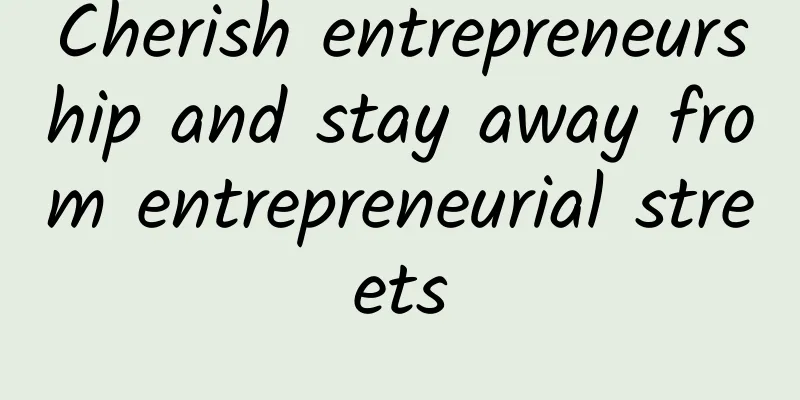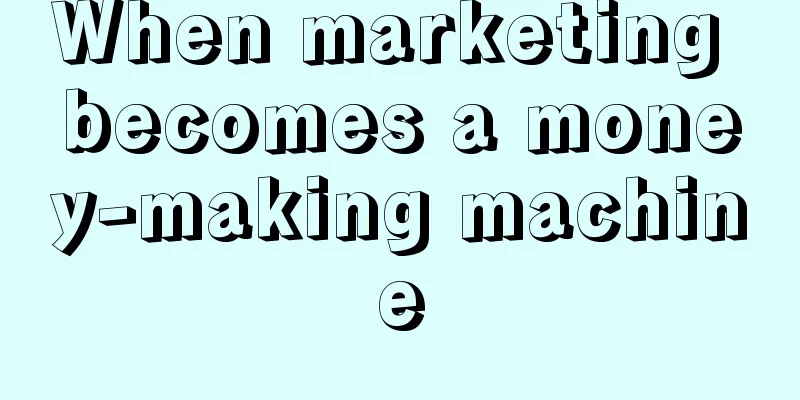Cherish entrepreneurship and stay away from entrepreneurial streets

|
In fact, when I was invited to join Entrepreneurship Street more than a year ago, I did not refuse. This "Entrepreneurship Street" located in Haidian Book City, Zhongguancun, Beijing, is now a tourist attraction project that showcases Beijing as the core base for technology entrepreneurship and venture capital in the world. It has a constant flow of visitors every day. Outsiders usually regard it as a mirror entrance to Beijing's entrepreneurial environment and ecology - whether it is Pan Shiyi, chairman of SOHO China, who is preparing to test the waters in the field of technology entrepreneurship, or foreign media trying to get a glimpse of China's entrepreneurial environment, and officials at all levels of Chinese government - from Haidian District to Beijing and then to central ministries and the State Council, if they want to declare support for the public to engage in technology entrepreneurship, then coming to the "Entrepreneurship Street" is one of the most appropriate actions to send this signal... All of the above are the reasons why this street can always be so lively. In addition, there are those people who we affectionately call "entrepreneurs" and "wantrepreneurs". Without their support and participation, this place would not be lively. Not only did I not refuse, I even participated in the discussion of the English name of the street at the time - "InnoWay" is a very fashionable name. At that time, our Beijing office (of course, referring to PingWest) was in Dinghao Building in Zhongguancun, and it only took 5 minutes to walk to the "Entrepreneurship Street" that was about to be completed. But the final result was that almost at the same time as the street was put into operation, we moved out of Zhongguancun and moved to a courtyard house near Shichahai. I declined the invitation from the operator of "Entrepreneurship Street". Now I think there are three main reasons: The first reason is undoubtedly that we (or I, to be more precise) like Siheyuan too much. When the idea of renting a Siheyuan as an office location popped up in the cracks of my brain, I told my entire core management team about it. No one objected and they all accepted the idea excitedly. Then we were lucky to find a suitable Siheyuan in three weeks. The second reason is that we feel that the entire Zhongguancun area is not suitable for daily life and behavior. We always feel that something is missing. In addition to having top Internet companies, excellent software engineers, entrepreneurial incubators and top universities, Zhongguancun lacks another kind of "soft power". Silicon Valley in the United States is actually the most popular area for hippie culture in the United States after the war. Until now, it is not only a part of the "Silicon Valley spirit", but also a very important part of mainstream American culture. Zhongguancun has been lacking such cultural support from more than 30 years ago to the present, so it always has a special pure and unrestrained atmosphere. The feeling of a weak humanistic background is like this. The third reason is the most important one. When we were seriously considering entering the "Entrepreneurship Street", we learned about the first wave of institutions that had already settled in (including those that had already settled in) this street. They included at least 3 entrepreneurial-themed coffee shops, 3 co-working spaces, 2-3 incubators and 3 technology media. There is no doubt that most of them are players in the field of technology entrepreneurship worthy of respect, but the too similar faces began to make me feel a little strange. If only this street has accommodated at least 3 technology media, I am of course the most concerned - although I may not be worried that many poaching and job-hopping will be completed from the beginning to the end of the street. But the feeling of meeting peers on the same street is a bit like Wang Qiyao and Mrs. Yan who always have to meet on the attic balcony opposite each other in the same alley in Wang Anyi's "Song of Everlasting Regret". They have a knot in their hearts but have to maintain a decent posture, nodding to each other, and smiling like poppies on their faces. When we can no longer be a different enough being, we decide not to be on this street. In my opinion, this street, in addition to gathering the popularity of technology startups and building a consensus on the high attention of all sectors of society to technology startups, which has been done quite well, may lack a little bit of something, that is, the diversity of the players involved - in recent months, I heard that in addition to the at least 3 startup cafes, 2-3 co-working spaces and 3 technology media mentioned above, there are now at least 2-3 product crowdfunding and equity crowdfunding platforms - many of which are new business units extended from the above institutions. In short, the longer you stay on this street, the more similar everyone looks. And "difference" should be one of the most important characteristics of technology entrepreneurship and technological innovation, isn't it? When everyone looks more and more alike, the differences are unconsciously further eliminated. In such a collective unconsciousness, we are also worried that we will become more and more similar to other peers, rather than more and more different. After all, when thinking about technological innovation, we don’t want to grow the wings of incubators, coffee shops, and equity crowdfunding. By the same token, when the active players on a "startup street" have a high degree of overlap and become more and more similar, the startup street as an "ecosystem" will also go to the opposite side of the ecosystem. The players involved will become unable to cooperate with each other, and more will be full of gunpowder confrontation and close confrontation as soon as the window is opened. When you come out of a startup coffee shop and walk a few steps to the right to walk into the door of another startup coffee shop, or when you cross the street less than 50 meters away and see at least three institutions on both sides hanging up promotional signs with the word "crowdfunding", this feeling will be very real. Does this really help the players involved become stronger? There is a very interesting thing - not long ago, Vice Premier of the State Council Liu Yandong came to Entrepreneurship Street to inspect the technology entrepreneurship ecology in Beijing and hosted a symposium on technology entrepreneurship on this street. Participants in the venture capital ecosystem invited to share at the meeting included Microsoft Ventures Accelerator CEO Gao Xinxin, Tsinghua University President Qiu Yong, Zhen Fund founder Xu Xiaoping, Qihoo 360 founder Zhou Hongyi, Face++ founder Yin Qi and Tiancheng Technology's "grassroots entrepreneurs" - except for the last "grassroots entrepreneur" who started his career at Garage Coffee on Entrepreneurship Street, the other players usually do not move around on Entrepreneurship Street, and some are even far away from Haidian District. Yes, "Entrepreneurship Street" is the foothold for some activities and ceremonies related to technology entrepreneurship and investment, but it does not mean that the players on this street can get anything. But everything here can easily fall into the collective unconsciousness and collective carnival of "huddling together for warmth", and while enjoying the carnival, it is inevitable to disturb each other - every time when SOHO China Chairman Pan Shiyi and other social celebrities, officials in charge of the Ministry of Science and Technology, Beijing Party and Government officials and State Council officials come to the Entrepreneurship Street to inspect work, the whole street will enter a boiling state, and a large number of players will come out in full force. The whole street is crowded with people watching, taking pictures, cheering and "real-time broadcasting on WeChat Moments". Everyone will gain an indescribable self-confidence and a sense of mission to "witness history" from it, feeling that they have stood at the top of the wave and the center of the stage, and have received unprecedented care from "leaders" and "bigwigs"; many people try to squeeze into the core circle close to "leaders" and "bigwigs", or let their incubators, office spaces, cafes and crowdfunding platforms get a moment of patronage and have a chance to shine. The more intense this rush is, the more excited the players involved will be; the more people gather on the street, the warmer people feel, and the more confident they feel that "the career will definitely succeed". This is the stove effect of huddling together for warmth, and the last glimmer of light that the illusion of each individual is infinitely close to reality at that moment. These players, who usually have highly overlapping businesses and are full of competition with each other, are on the same street at this moment. They really need to embrace each other affectionately to get a moment of excitement, just like marijuana. But truly smart entrepreneurs and investors do not need to rely on this method to keep each other warm. And this collective unconsciousness is also reflected in the fact that several players on the same street staged the "Ice Bucket Challenge" on the same day, and groups of entrepreneurs, pseudo-entrepreneurs, investors and pseudo-investors gathered in several venture capital coffee shops to talk about "trends", "pain points", "O2O" and "future trends". The grassroots entrepreneurs with special skills who waited for various investors in the coffee shops, "I have a great idea, give me 1 million and I can create another Momo", and the long queues at the door of offline fast food restaurants dubbed "Internet thinking" - it seems that what they are eating is not Roujiamo or pancakes, but entrepreneurial soul-returning pills. Everything is high. Among all these highs and self-highs, the only thing you can’t find is users. The original driving force behind technology entrepreneurship and investment in technology entrepreneurship projects is to create greater commercial returns and value, and there is no doubt that this can only be achieved by obtaining the needs of a large number of real users. However, there are no real technology consumers and users on the entrepreneurial street. There are only a group of technology service providers and “idea-based” entrepreneurs lingering on the edge, as well as a collective carnival that is getting higher and higher. The higher you are, the more you can’t help yourself, and the more you feel that you are the whole world. The ordinary people, those who may really become consumers of technology products, are further away from you. Those whose life trajectories and lifestyles are being changed by technological innovation are in the mountains and rivers, not in the entrepreneurial streets. Smart entrepreneurs should make their livings in the mountains and rivers. |
<<: Foxconn starts selling used iPhones every Wednesday at 12:00
>>: Android's official pull-down refresh component SwipeRefreshLayout
Recommend
Analysis of the top 100 most popular Tik Tok videos: Why isn’t your Tik Tok popular yet?
At present, Douyin can be said to be the most pop...
12 tips to achieve rapid growth of user pool!
In this series of courses, we will share with you...
Promotion | Introduction to Fanstong Products
The first in a series of popular science articles...
From 0 to 1, how to carry out overseas operations and promotion?
Establish a promotion and operation system around...
The launch will be at 23:08 tomorrow! The crew of Shenzhou 15 astronauts is confirmed to be: Fei Junlong, Deng Qingming, and Zhang Lu! Netizens: Old Deng has realized his dream, heading for the stars and the sea!
According to the China Manned Space Engineering O...
Don't touch it! The "smart drugs" that are popular among parents are actually psychotropic drugs, and taking them may cause addiction
Expert of this article: Wang Weibao, Endocrinolog...
Why doesn’t anyone drink “pig milk”? Is it because it tastes bad?
Milk and dairy products are rich in nutrients, an...
Why is sepsis so likely to kill people? Six facts you must know
Speaking of "sepsis", you may feel unfa...
Satellite reveals! This is how the United States treats minors who enter the country illegally!
Every day, hundreds of remote sensing satellites ...
Why are there two ways to define "new user"?
There are two ways to define " new users &qu...
Sony Z2 beats HTC M8
In a foreign media test earlier, HTC M8 beat Sony&...
3 information flow advertising cases in the financial industry, watch them all at once, so awesome!
Today, the editor has compiled 3 cases of informa...
Don't lose weight randomly! These unreliable weight loss methods may damage your bones
The matter of losing weight The most difficult pa...
6 ways to increase user activity!
How to maintain and increase activity and improve...
How much does it cost to make an underwear mini program on the Anyang market?
How much does it cost to produce the Anyang under...









